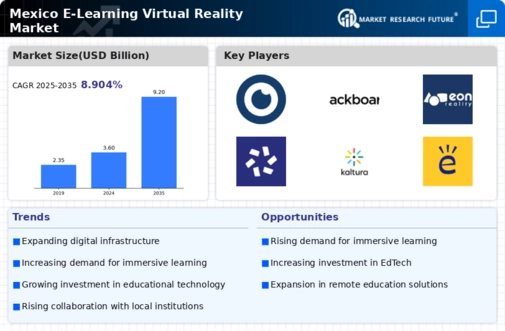The Mexico E-Learning Virtual Reality Market showcases an emerging and competitive landscape driven by technological advancements and an increasing demand for innovative learning solutions. As education systems evolve, institutions are seeking immersive experiences that can enhance learning outcomes and engagement among students.
In this environment, various companies are vying for a strong foothold by offering cutting-edge solutions that integrate virtual reality with traditional learning methods. The growing emphasis on digital transformation in education highlights the importance of strategic partnerships, innovation in product offerings, and tailored solutions that meet the specific needs of the Mexican market.
Companies that can leverage their technological expertise, understand local educational contexts, and provide user-friendly platforms will likely gain a competitive edge.Prowise has established a presence in the Mexico E-Learning Virtual Reality Market with a focus on providing innovative educational technology solutions. The company's strengths lie in its ability to deliver high-quality, interactive learning tools that engage students and support educators. Prowise emphasizes the integration of user-friendly interfaces and immersive content that facilitates effective learning experiences.
Their commitment to enhancing educational outcomes through technology is evident in their responsive support for teachers and schools, allowing them to seamlessly incorporate virtual reality into their curricula. This adaptability and responsiveness to the needs of the Mexican educational sector position Prowise as a strong competitor in the rapidly evolving E-Learning landscape.Blackboard operates in the Mexico E-Learning Virtual Reality Market, providing a suite of educational technology solutions designed to enhance learning and teaching experiences. Key products offered by Blackboard include learning management systems, virtual classroom tools, and analytics solutions that allow educational institutions to monitor and improve student performance.
The company's strong market presence is bolstered by its reputation for reliable service and robust features tailored for both educators and learners. Blackboard’s strengths are highlighted by its focus on creating engaging and collaborative learning environments, which are increasingly important in a digital-first education landscape.
Additionally, through strategic mergers and acquisitions, Blackboard has expanded its offerings and market reach, reinforcing its commitment to providing effective educational solutions that resonate well within the Mexican market. Their ability to adapt to local requirements while maintaining high standards of technological innovation ensures that they remain a significant player in this evolving sector.






















Leave a Comment